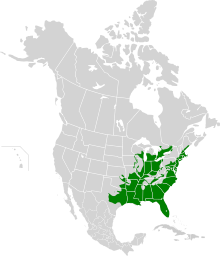Sternotherus
Sternotherus is a genus of turtles in the family Kinosternidae including six species commonly known as musk turtles. The genus is endemic to North America, occurring in the eastern third of the USA and southeast Ontario, Canada. Musk glands positioned near the bridge of the shell can produce foul smelling secretions when the turtles are threatened, although genital handling does not normally provoke a response. Sternotherus are moderately small turtles, with the largest species in the genus, the razor-backed musk turtle (S. carinatus), attaining a maximum of 17.6 cm. in shell length. The carapace is characteristically oval and domed (an exception being the flattened musk turtle, S. depressus), with most species having one or three keels on the back which may become smoother and obscure with age in some species. Musk turtles are generally drab in color, mostly black, gray, brown, olive, or ocher, which aid in camouflaging them in their natural habitats. The head is relatively large and stout, marked with spots, streaks, or strips. The plastron has only 10 or 11 scutes, as opposed to 12, a more common condition in North American turtles. The tail is short, with males having a horny claw like tip.
Sternotherus are largely aquatic, however some species frequently bask on fallen logs or rocks emerging from the water, and eastern musk turtles (S. odoratus) occasionally leave the water to forage. Sternotherus are omnivorous and opportunistic generalist in their diet, although inclining toward being carnivorous, with mollusks (gastropods and bivalves) and insects making up a significant percentage of their diet. Some older adults develop large musculature on the head and expanded, crushing jaw surfaces aiding in the consumption of mollusk. Musk turtles are oviparous with females producing one to six clutches a year. The typical clutch size is two to four eggs, although clutches may range from one to 13. The sex of the hatchlings is determined by the incubation temperature. The eggs are deposited in shallow nest excavated on the banks or in woodlands a few meters from the water. Eggs may be laid singly, or in groups, and some species are known to share communal nesting areas.[2]: 471–472, 511-535 pp.
The generic name Sternotherus is Greek meaning hinged breast or chest, referring to the hinged plastron.[3] The trivial names, or specific epithets include: carinatus – Latin for keeled in reference to the shape of the carapace;[4] depressus – Latin for pressed down or low also referring to the shape of the carapace;[5] intermedius – Latin for intermediate, historically believed to be a hybrid from between S. minor and S. peltifer;[6] minor – Latin referencing its relatively small size compared to S. carinatus;[7] odoratus – Latin for having an odor, referring the smell of the musk produced by its scent glands;[8] peltifer – Latin meaning bearing a small shield, in reference to the small size of the scutes on the bridge the species.[2]: 647-648 pp. [7]
Sternotherus is one of four genera in the family Kinosternidae including: narrow-bridged musk turtles (Claudius), American mud turtles (Kinosternon), giant musk turtles (Staurotypus), and musk turtles (Sternotherus). Sternotherus are closely related, similar in appearance, and sympatric in much of their range with some species of mud turtles (Kinosternon), and the two genera constitute the subfamily Kinosterninae within the family Kinosternidae. In the past some taxonomist placed Sternotherus in the synonymy of the genus Kinosternon[9][10] but they are generally regarded as two separate genera with six species currently (2022) recognized in the genus Sternotherus.[11]
Nota bene: A binomial authority in parentheses indicates that the species was originally described in a genus other than Sternotherus.
_and_mud_turtles_(Kinosternon).jpg/440px-Distinguishing_characteristics_of_musk_turtles_(Sternotherus)_and_mud_turtles_(Kinosternon).jpg)


_(cropped).jpg/440px-Eastern_Musk_Turtle_(35369688276)_(cropped).jpg)
.jpg/440px-Sternotherus_minor_peltifer_Jungtier_ca._2_Monate_alt_ventral_(cropped).jpg)